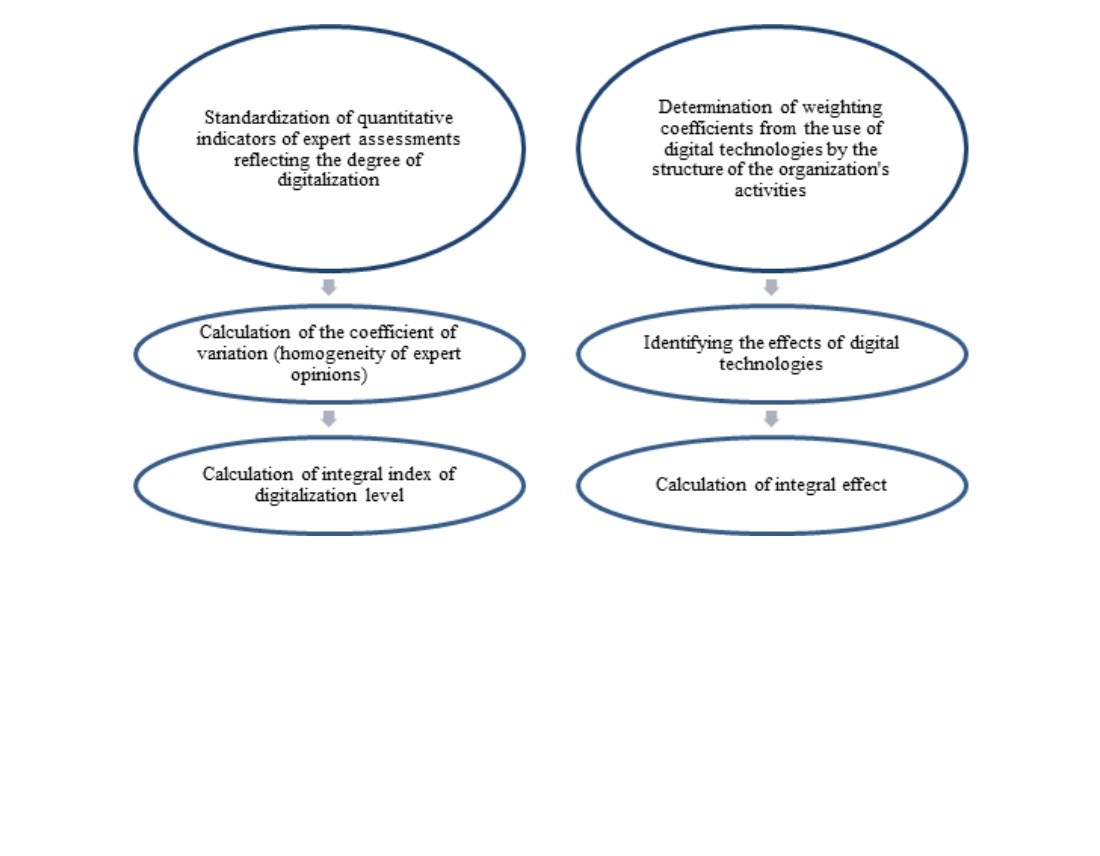Розробка методики оцінки ефективності агропромислового підприємства при використанні цифрових технологій
DOI:
https://doi.org/10.15587/1729-4061.2024.312486Ключові слова:
цифровізація, агропромисловий комплекс, цифрові технології, методика оцінки, матриця оцінки ефективності, експертна оцінкаАнотація
Об'єктом дослідження є діяльність агропромислового підприємства з використання цифрових технологій. Вирішено завдання методики оцінки ефективності використання цифрових технологій агропромисловим підприємством. Отримані наступні результати:
– розроблено авторську методику оцінки ефективності використання цифрових технологій агропромисловим підприємством на підставі експертної оцінки та системи показників. Результати оцінки інтерпретовані відповідно до матриці перетину показника цифровізації та ефекту від використання цифрових технологій від Аутсайдера (0–0, 25; <1) до Лідера (0,95–1; ≥1);
– отриманий коефіцієнт узгодженості (76 %, χ2=41,9) свідчить про високу злагодженість роботи експертної групи, послідовність та якісну оцінку в процесі апробації методики;
– апробація запропонованої методики в АТ «Атамекен-Агро» пройшла успішно й показала обґрунтованість та зручність даної методики. Агропідприємство стало лідером у 2023 році з показниками рівня цифровізації – 0,83 та ефекту від використання цифрових технологій – 12,5.
Наведені вище результати пояснюються припущенням про можливість використання методу експертних оцінок для оцінки ефективності використання цифрових технологій підприємством та застосування матриці прийняття рішень на основі двох показників.
Особливістю отриманих результатів є розробка методики оцінки рівня цифровізації за трьома основними напрямками та її застосування в поєднанні з оцінкою економічного ефекту від цифрових технологій.
Запропонована методика може бути використана не тільки підприємствами, які бажають оцінити ефективність цифрових технологій, а й зацікавленими сторонами.
Спонсор дослідження
Посилання
- Kemp, S. (2023). Digital 2023: Global Overview Report. Available at: https://datareportal.com/reports/digital-2023-global-overview-report
- Shelenko, D., Balaniuk, I., Sas, L., Matkovskyi, P., Kozak-Balaniuk, I. (2020). Mechanism of transformation of agricultural enterprises in terms of innovative development. Journal of Vasyl Stefanyk Precarpathian National University, 7 (3), 115–127. https://doi.org/10.15330/jpnu.7.3.115-127
- Schuh, G., Anderl, R., Gausemeier, J., Hompel, M., Wahlster, W. (Eds.). (2017). Industrie 4.0. Maturity Index. Managing the Digital Transformation of Companies. Munich: Herbert Utz Verlag, 60. Available at: https://www.acatech.de/wp-content/uploads/2018/03/acatech_STUDIE_Maturity_Index_eng_WEB.pdf
- Digital Maturity Model. Achieving digital maturity to drive growth. Deloitte. Available at: https://www.tmforum.org/wp-content/uploads/2018/08/Deloitte-DMM.pdf
- Are you ready for digital transformation? Measuring your digital business aptitude. KPMG. Available at: https://assets.kpmg.com/content/dam/kpmg/pdf/2016/04/measuring-digital-business-aptitude.pdf
- Digital Champions. Successful in connected and autonomous supply chain ecosystems. PwC. Available at: https://www.pwc.com/gx/en/industries/industrial-manufacturing/digital-supply-chain/digital-champions-2025.html
- Pastor, J. T., Aparicio, J., Zofío, J. L. (2022). Benchmarking Economic Efficiency. In International Series in Operations Research & Management Science. Springer International Publishing. https://doi.org/10.1007/978-3-030-84397-7
- Zhang, X., Lu, J., Li, H., Xv, Y. (2023). Innovative Transformation and Practice of Internationalized Business Management Model of Central Enterprises in the New Era. Proceedings of the 2023 3rd International Conference on Enterprise Management and Economic Development (ICEMED 2023), 137–150. https://doi.org/10.2991/978-94-6463-224-8_20
- Najar, B. W. (2020). The Effectiveness Management in Organizations. Journal of Education and Culture Studies, 4 (4), p19. https://doi.org/10.22158/jecs.v4n4p19
- Zhang, T., Shi, Z.-Z., Shi, Y.-R., Chen, N.-J. (2021). Enterprise digital transformation and production efficiency: mechanism analysis and empirical research. Economic Research-Ekonomska Istraživanja, 35 (1), 2781–2792. https://doi.org/10.1080/1331677x.2021.1980731
- Kosnikova, O. V., Amirova, E. F., Aygumov, T. G., Burda, A. G., Kosnikov, M. S. (2022). Justification Of Optimal Material And Technical Structure Of Agricultural Enterprise. European Proceedings of Social and Behavioural Sciences, 248–254. https://doi.org/10.15405/epsbs.2022.02.30
- Usai, A., Fiano, F., Messeni Petruzzelli, A., Paoloni, P., Farina Briamonte, M., Orlando, B. (2021). Unveiling the impact of the adoption of digital technologies on firms’ innovation performance. Journal of Business Research, 133, 327–336. https://doi.org/10.1016/j.jbusres.2021.04.035
- Yang, M., Fu, M., Zhang, Z. (2021). The adoption of digital technologies in supply chains: Drivers, process and impact. Technological Forecasting and Social Change, 169, 120795. https://doi.org/10.1016/j.techfore.2021.120795
- Overall equipment effectiveness. What is OEE? Available at: https://www.oee.com/
- Clapp, J., Ruder, S.-L. (2020). Precision Technologies for Agriculture: Digital Farming, Gene-Edited Crops, and the Politics of Sustainability. Global Environmental Politics, 20 (3), 49–69. https://doi.org/10.1162/glep_a_00566
- Brockova, K., Rossokha, V., Chaban, V., Zos-Kior, M., Hnatenko, I., Rubezhanska, V. (2021). Economic Mechanism of Optimizing the Innovation Investment Program of the Development of Agro-Industrial Production. Management Theory and Studies for Rural Business and Infrastructure Development, 43 (1), 129–136. https://doi.org/10.15544/mts.2021.11
- Zhao, G., Liu, S., Lopez, C., Chen, H., Lu, H., Mangla, S. K., Elgueta, S. (2020). Risk analysis of the agri-food supply chain: A multi-method approach. International Journal of Production Research, 58 (16), 4851–4876. https://doi.org/10.1080/00207543.2020.1725684
- Axtell, R. L., Farmer, J. D. (2022). Agent-based modeling in economics and finance: Past, present, and future. INET Oxford Working Paper No. 2022-10. Available at: https://oms-inet.files.svdcdn.com/production/files/JEL-v2.0.pdf
- Ciruela-Lorenzo, A. M., Del-Aguila-Obra, A. R., Padilla-Meléndez, A., Plaza-Angulo, J. J. (2020). Digitalization of Agri-Cooperatives in the Smart Agriculture Context. Proposal of a Digital Diagnosis Tool. Sustainability, 12 (4), 1325. https://doi.org/10.3390/su12041325

##submission.downloads##
Опубліковано
Як цитувати
Номер
Розділ
Ліцензія
Авторське право (c) 2024 Zhanar Yerzhanova, Nazym Akhmetzhanova, Assel Tapalova, Zhumakyz Gabbassova, Aigul Shadiyeva, Gulistan Akhmetova, Yerlan Onlassynov, Marat Saparbaev

Ця робота ліцензується відповідно до Creative Commons Attribution 4.0 International License.
Закріплення та умови передачі авторських прав (ідентифікація авторства) здійснюється у Ліцензійному договорі. Зокрема, автори залишають за собою право на авторство свого рукопису та передають журналу право першої публікації цієї роботи на умовах ліцензії Creative Commons CC BY. При цьому вони мають право укладати самостійно додаткові угоди, що стосуються неексклюзивного поширення роботи у тому вигляді, в якому вона була опублікована цим журналом, але за умови збереження посилання на першу публікацію статті в цьому журналі.
Ліцензійний договір – це документ, в якому автор гарантує, що володіє усіма авторськими правами на твір (рукопис, статтю, тощо).
Автори, підписуючи Ліцензійний договір з ПП «ТЕХНОЛОГІЧНИЙ ЦЕНТР», мають усі права на подальше використання свого твору за умови посилання на наше видання, в якому твір опублікований. Відповідно до умов Ліцензійного договору, Видавець ПП «ТЕХНОЛОГІЧНИЙ ЦЕНТР» не забирає ваші авторські права та отримує від авторів дозвіл на використання та розповсюдження публікації через світові наукові ресурси (власні електронні ресурси, наукометричні бази даних, репозитарії, бібліотеки тощо).
За відсутності підписаного Ліцензійного договору або за відсутністю вказаних в цьому договорі ідентифікаторів, що дають змогу ідентифікувати особу автора, редакція не має права працювати з рукописом.
Важливо пам’ятати, що існує і інший тип угоди між авторами та видавцями – коли авторські права передаються від авторів до видавця. В такому разі автори втрачають права власності на свій твір та не можуть його використовувати в будь-який спосіб.










